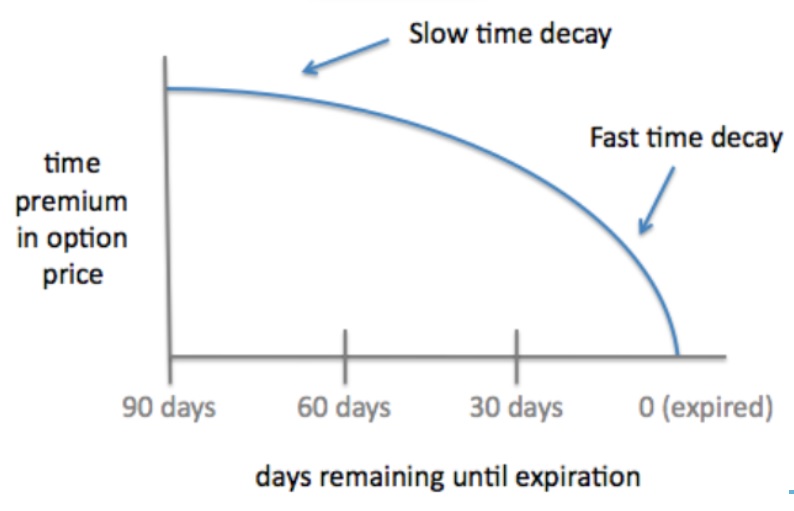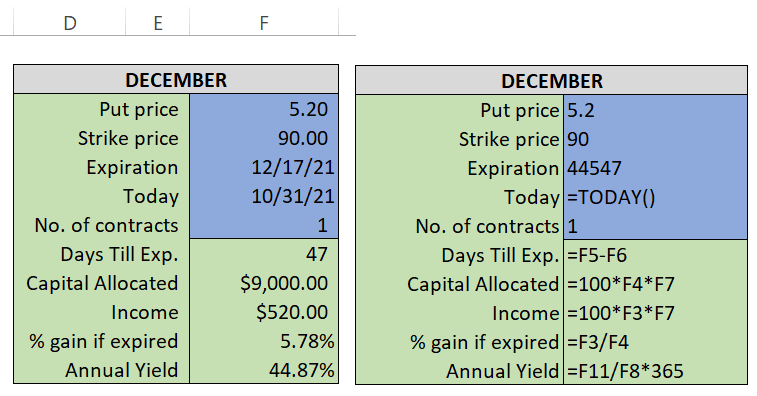
[Editor’s Note: This is part II of our series on investment income plays selling put contracts. In Part I I explained put contracts and how to sell them for income.
Today, we’ll cover how to pick the right stocks and which put contracts to use with this strategy.]
In part I of this series I explained how the put-selling process works.
- We covered what a put contract IS (an agreement between traders)…
- How selling a contract is the same as entering an agreement…
- That you get paid when you enter one of these contracts…
- The potential that you may be required to buy shares of stock…
- How your brokerage account sets aside cash until the position is closed…
- That each put contract has an expiration date…
- And the three possible outcomes for each income trade…
It was a lot to cover I know. And you may still have questions! Please feel free to comment below or send me an email with your specific questions. Remember, I can’t give individual investment advice. But I CAN use your question to clarify the process for everyone here.
Once you understand how the process works, you still have some decisions to make.
Like which stocks to use and then which specific put contracts are best to sell.
We’ll cover those decisions today before moving on to some of the great advantages of this approach in the next few installments.
The Best Stocks for Income Plays
When searching for the best income plays to use with this strategy, I always start with a watch list of stocks I would like to own. In other words, I only use this strategy for stocks I am confident will trade higher.
It’s a good idea to always have a watch list of companies that you’re following. That way, when it’s time to set up a new income play, you’ve already got a list of great candidates you’ve been researching. (Here’s a link to sign up for a free copy of my current watch list.)
I like to set up income plays when one of my favorite watch list stocks trades with a particular chart pattern. This helps improve the likelihood that the stock will move higher in the near future. Some of these patterns include:
- Cup with handle — I wrote about this pattern here.
- Pullback to support
- Double bottom
- Breakout above resistance
- Oversold rebound
We’ll talk more about these setups in the future. The key is to pick stocks you would want to invest in, and to set up your income play at a time when the stock is most likely to trade higher.
Pay special attention to which industries are in play.
For instance, if the market is facing a high level of inflation, you may want to consider bank stocks, gold miners or producers of tangible items like oil and construction materials.
And when other investors are confident and the market is moving steadily higher, tech stocks can be great candidates for our income plays.
Once you have a stock picked out, the next step is to look at which put contract to sell.
Picking the Right Put Contract
For every active stock traded on U.S. exchanges there are dozens of put contracts to pick from. How do you know which contract to sell?
I have two requirements for my income plays:
- They must be out of the money…
- And they must expire in the near future.
A put contract is “out of the money” if the strike price is below the stock’s current market price.
For example, Schlumberger (SLB) recently closed at $32.24. You could sell a $30 put contract which is “out of the money”
Selling this put contract gives someone the right to sell SLB to you at $30. Since the stock is trading at $32.24, the buyer wouldn’t want to exercise his “right” today. After all, they could get more money by selling at the market price.
So the $30 put contract is considered “out of the money” because $30 is below the current market price for SLB.
Selling a put contract that expires in the near future also works to your advantage. I usually sell put contracts that expire between 3 and 8 weeks in the future.

As we get closer to the expiration date, the value of a put contract decreases. This is known as “time decay.”
Think about it this way… You would pay less for an insurance policy that only protected you for a couple weeks. The same holds for the price traders will pay for put contracts.
The closer the expiration date, the faster the value for put contracts deteriorate. Since we sell put contracts to collect income, faster time decay works in our favor.
Eventually we want our put contract to expire (and disappear from our account), or we’d like to buy it back at a lower price. Either way, faster the time decay grows our profits more quickly.
Measuring Our Income Play Ahead of the Trade
To pick the best income plays for our put-selling strategy, you need to be able to calculate the annualized rate of return for selling a put contract.
Remember, selling a put contract is the same as agreeing to buy shares of stock. And your broker will set aside the cash (or margin buying power) in case you’re required to buy those shares.
A wise investor will ask “What am I paid for setting this cash aside?”
You should make sure the put contract pays you an attractive amount of income for the money you’re setting aside. And you must also consider the time until expiration.
I use a simple spreadsheet to calculate the rate of return for my income plays.

The left side shows the table which calculates a 44.87% annualized rate of return for a specific put contract. And for you excel nerds (like me), I’ve included a table that shows the calculations for each cell. This way you can recreate the table yourself!
Let’s look at the put contract in the example table above:
- The price is $5.20 for selling the put contract.
- The put contract has a $90 strike price.
- Our contract expires in 47days.
- We must set aside $9,000 for this income play.
- We receive $520 from selling the contracts.
- That $520 represents a 5.78% rate of return.
- The annualized rate of return is 44.87%.
So if we could continually make trades like this with all of our capital throughout the entire year, our account value would grow by 44.87%.
Balancing Risk and Reward
When you calculate the return for different put contracts, you’ll notice some big differences in annualized rates of return. Here are some concepts to help explain (and to help you pick the best contracts).
- The closer the put’s strike price to the actual market price, the more income.
- But keep in mind, this means there’s probably a higher chance the stock could trade below that level.
- The more volatile a stock’s expected price movement, the more income you’ll receive.
- There’s an art to picking plays volatile enough for good income, but plays that are not too risky.
It’s not reasonable to expect every trade to work out perfectly. Some plays lose money. Others may be closed out for smaller gains.
There are also situations where a trade can be closed out early and lock in a higher annualized rate of return.
In the next installment, we’ll discuss putting together a portfolio of income plays. We’ll talk about strategies for getting the max value for each income play. And most importantly, we’ll see how much money you can really make with this strategy.
